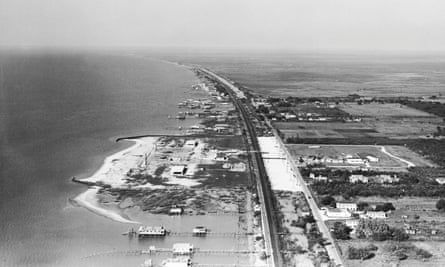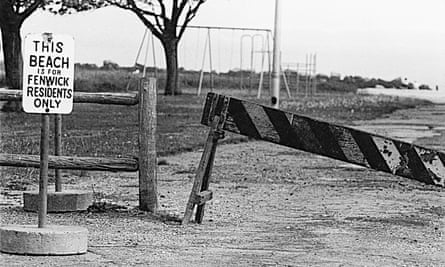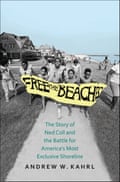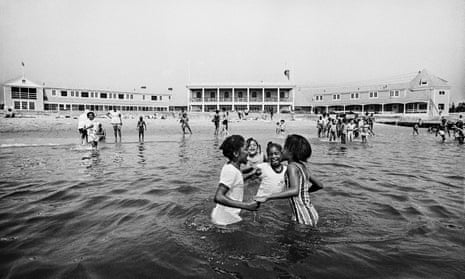Summer has arrived, which, for many Americans, means day camps for children, afternoons lounging by a pool, and weekend trips to the beach. But for many others, summer brings new burdens, frustrations and fears: the end of free or reduced meals for children at schools, the added cost of childcare and the search – often in vain – for safe, affordable and accessible places to play and cool off on a hot day.
Summers have long been America’s most segregated season. Nowhere is this more evident than along the nation’s beaches and coasts, one of the chief destinations for vacationers and pleasure seekers, and a perennial site of racial conflict and violence. The infamous 1919 Chicago race riot, which lasted seven days and claimed 38 lives, began on the shores of Lake Michigan, when white youth gang members stoned to death a black teenager named Eugene Williams after he had accidentally drifted across a color line in the water. In its aftermath, African Americans learned to avoid the city’s lakefront. As a child, black Chicagoan Dempsey Travis remembers, “I was never permitted to learn to swim. For six years, we lived within two blocks of the lake, but that did not change [my parents’] attitude. To Dad and Mama, the blue lake always had a tinge of red from the blood of that young black boy.”
In the decades that followed, local governments across the US enacted a host of policies and practices designed to segregate places of outdoor leisure by race and effectively exclude people of color from public beaches. In the south, those methods were quite explicit. Coastal cities such as Norfolk, Virginia, Charleston, South Carolina, and Miami, Florida, prohibited African Americans from stepping foot on any of their public beaches, and for years ignored blacks’ demands for public beaches of their own. Whites’ indifference to the health and humanity of black communities often had deadly consequences. Throughout the Jim Crow era, shockingly high numbers of black youth drowned each summer while playing in dangerous, and unsupervised, bodies of water. When white officials did respond to black demands for beaches and parks of their own, they invariably selected remote, polluted, often hazardous, locations. In Washington DC, officials designated Buzzard’s Point, a former dumping ground located downstream from a sewage plant, as an appropriate location for the city’s “colored” bathing beach. In New Orleans, it was a remote site on Lake Pontchartrain, 14 miles from downtown, surrounded on both sides by fishing camps that dumped raw sewage into the lake. One health official described the waters offshore as “grossly contaminated” and wholly unfit for bathing.

In the north, whites employed more subtle, but no less effective, methods of segregation. Predominantly white suburbs and towns in the north-east, for example, designated their public beaches for residents only, or charged exorbitant access fees for non-residents, or barred non-residents from parking near the shore, all designed to keep minority populations in neighboring cities out. City officials, meanwhile, failed to provide black neighborhoods with safe and decent places of public recreation and deliberately made beaches and pools frequented by middle-class whites inaccessible to the poor and people of color.
Here, too, whites’ determined efforts to keep black people out of their pools and off their beaches cost black children their lives. On a hot summer day in June 1968, teenagers Howard Martin and Lemark Hicks left their families’ low-income public housing units in Port Chester, New York, and went in search of a place to cool off. Hours later, scuba divers pulled their lifeless bodies from the depths of the Byram river, where the two African American boys had drowned while swimming, unsupervised, in the river’s dangerous currents. While the boys screamed for help, less than a mile away lifeguards kept a watchful eye over children playing in the surf at Byram Beach, one of three public beaches in the neighboring town of Greenwich, Connecticut. But despite its close proximity, these beaches, and the safety they afforded bathers, were not an option for Martin, Hicks, and all other black children living in Port Chester. They were for Greenwich residents only.
Such senseless tragedies fueled black unrest and played no small role in sparking urban uprisings during the long, hot summers of the 1960s. In 1968, public housing residents in Hartford, Connecticut, staged a series of protests following the drowning deaths of several children along a dangerous section of a river that snaked through their housing project. City officials had repeatedly ignored parents’ demands to fence off the area or, better yet, provide the neighborhood with a public swimming pool, and instead scolded parents for not keeping a better watch over their children. “This is what causes riots,” protest leader Barbara Henderson said in response. The Kerner commission concurred. In its 1968 report on the “riots” that had engulfed urban black America in previous summers, it listed “poor recreation facilities and programs” as the fifth most intense grievance of black populations in riot-torn cities, just behind policing practices, unemployment and underemployment, housing and education. In response, cities hastily built above-ground swimming pools and placed sprinklers on fire hydrants in black neighborhoods.

But aside from these modest gestures, little was done to address the underlying causes of summertime segregation and recreational inequality. In recent decades, fiscally distressed cities have slashed funding for outdoor recreation programs for disadvantaged children, and closed or sold off public parks, beaches and swimming pools in poorer neighborhoods, while affluent communities continue to employ the same tactics for keeping “undesirables” out of their parks and off their shores. Earlier this spring, officials in Westport, Connecticut, dramatically increased parking fees and slashed the number of passes sold to non-residents at its public beach. The move came after locals complained about the growing numbers of outsiders there the previous summer. In the exclusive community of Palos Verdes Estates, California, a gang of wealthy local whites (known as the “Lunada Bay Boys”) has been waging a decades-long campaign of terror against non-residents, especially African Americans, who seek access to the town’s public beach. Local residents have subjected visitors to beatings and assaults, racist epithets, sexual harassment, dog attacks, death threats, property destruction and vandalism, all with the tacit approval of local law enforcement. Officials in this and other affluent beachfront communities in Los Angeles, meanwhile, have for years thwarted attempts by the city’s regional transit authority to offer direct bus routes from black and brown inner-city neighborhoods to the beach. As a result, it is common to find black children living in Los Angeles who have never even seen the Pacific Ocean, much less spent a day on its shores.

Like schools and neighborhoods, the persistence of racial separatism in places of play didn’t just happen by chance. Nor does it, as some might claim, simply reflect people’s personal preferences. It is the result of public policies and private actions that, by design, aimed to segregate bodies of water by race and allow whites to claim the most desirable outdoor spaces to themselves. Many of these policies and practices remain in effect today. Undoing them is critical to making public space in America truly public, and to ensuring that all Americans enjoy the basic human right to leisure and recreation.
- Andrew W Kahrl is associate professor of history and African American Studies at the University of Virginia
